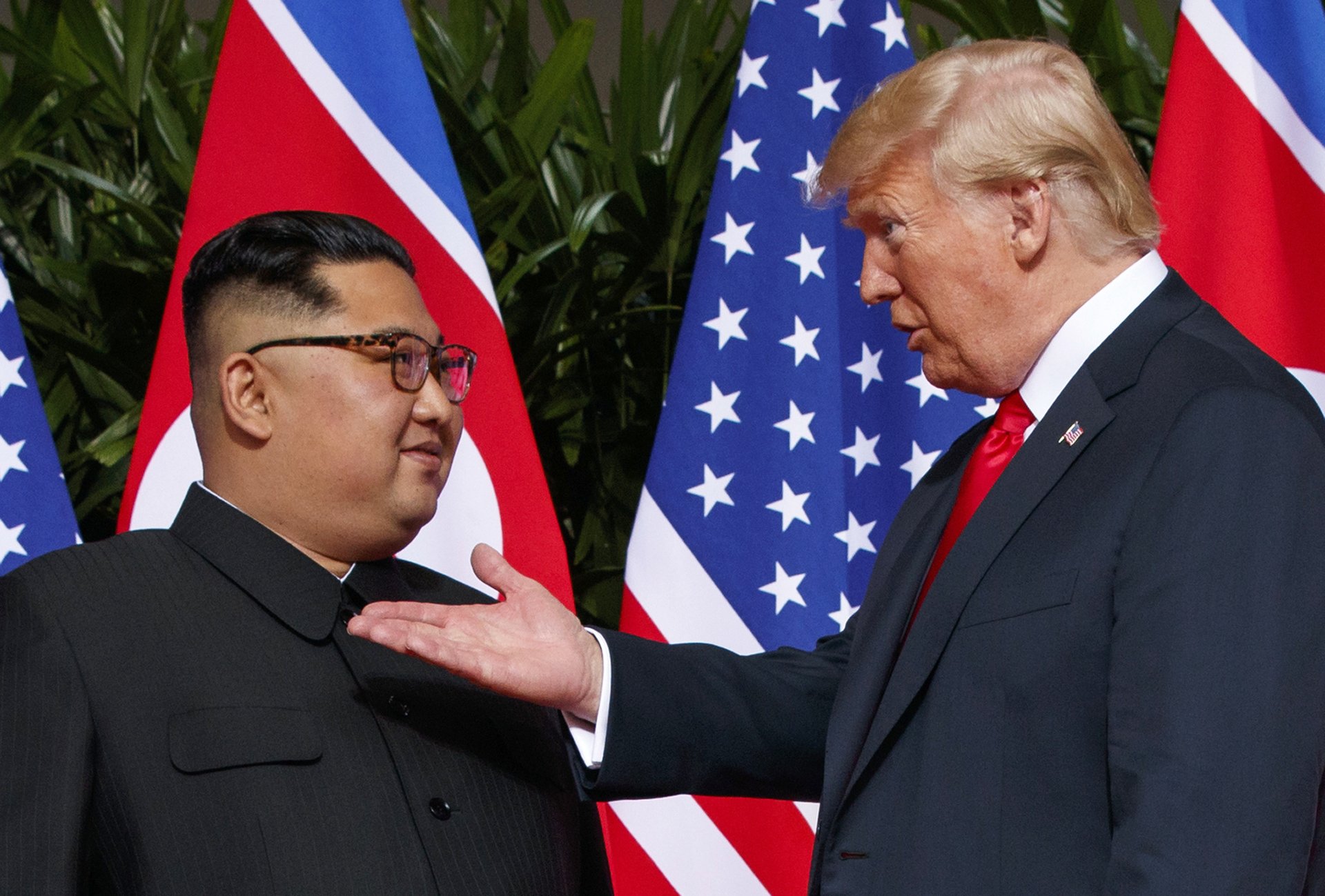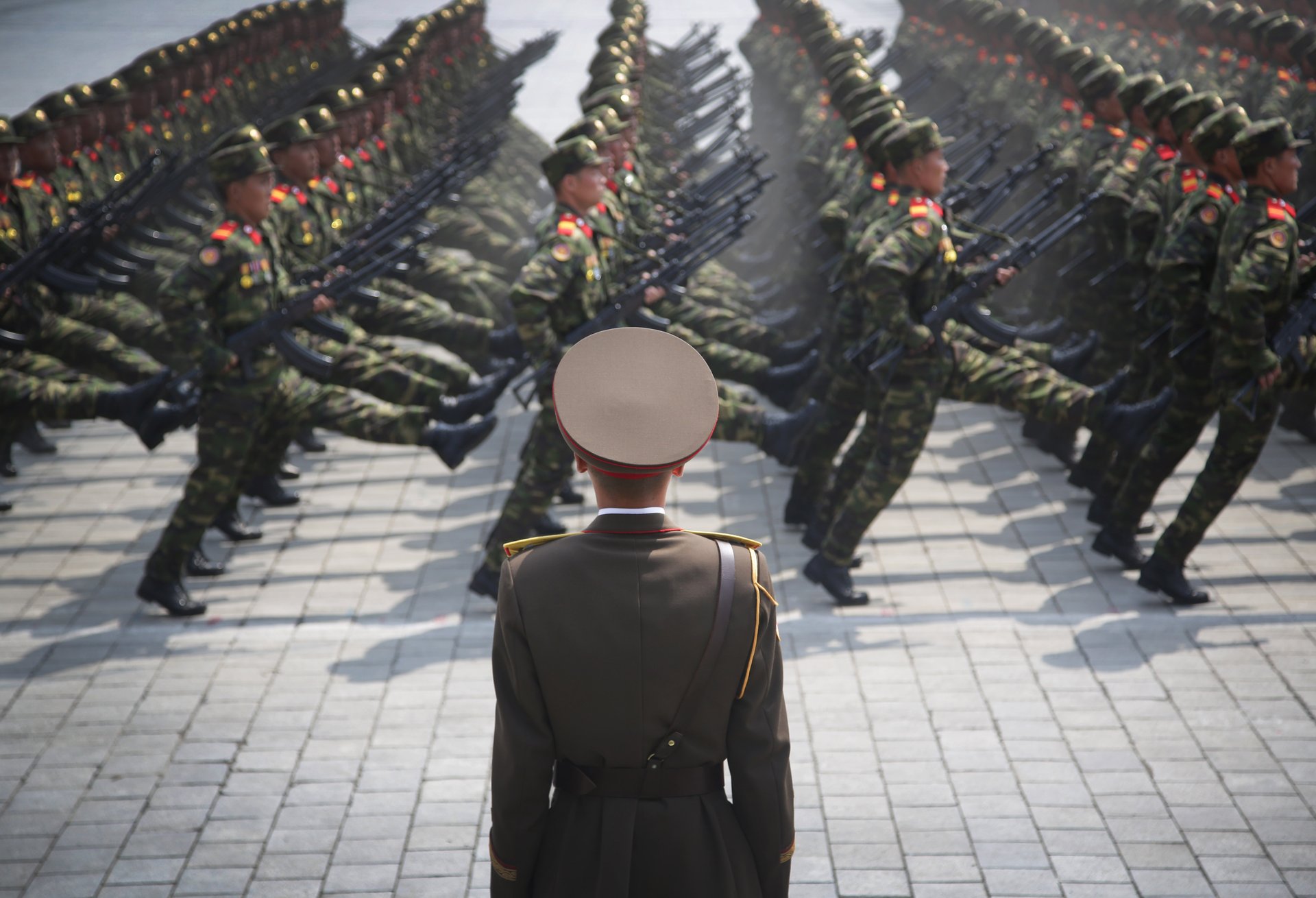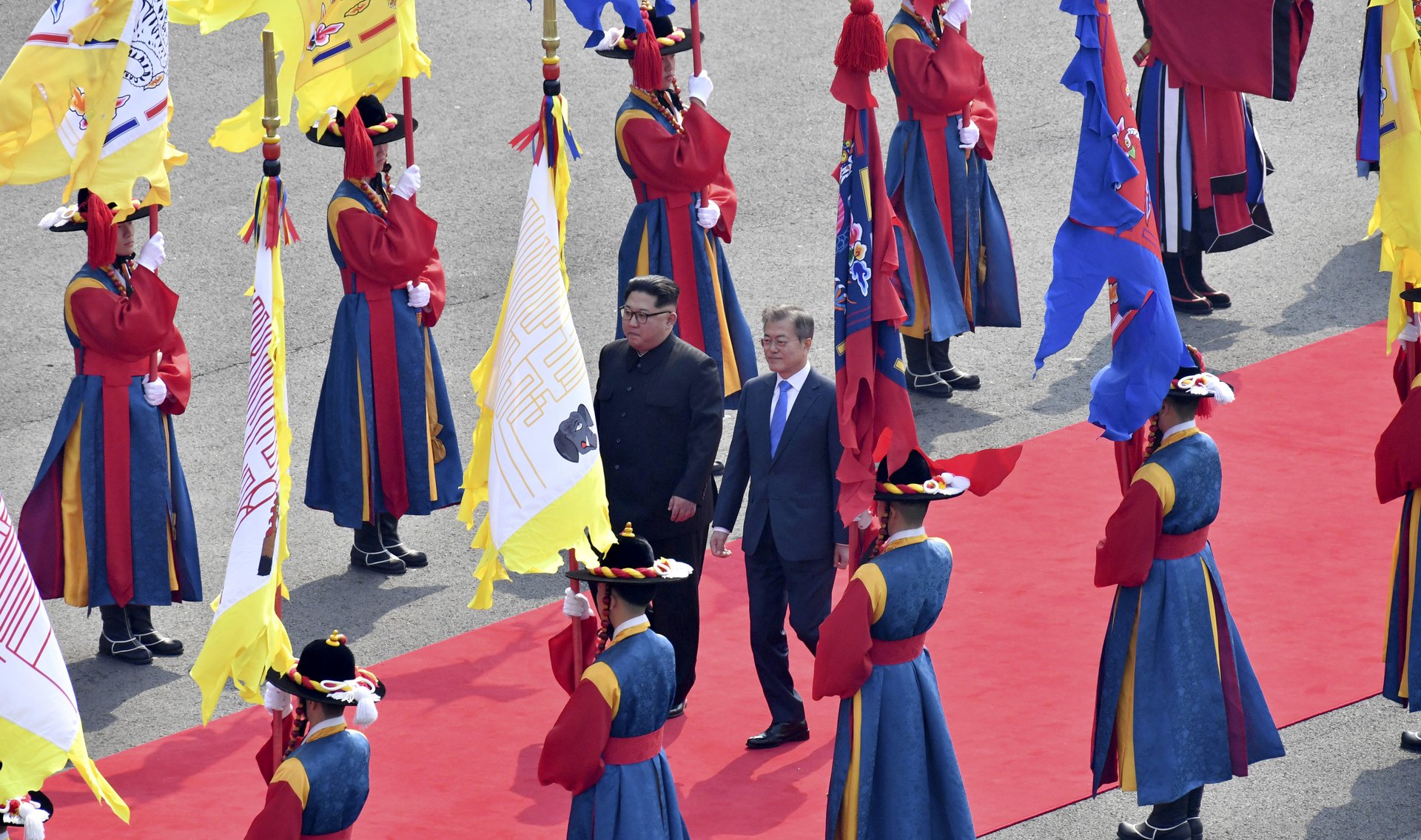The North Korean nuclear program is elaborate. For decades, the country has produced unknown quantities of enriched uranium and weapons-usable plutonium, stockpiled warheads and missiles, and vastly understated the breadth of the nation’s nuclear activities.
Any kind of serious denuclearization in North Korea will take years and will cost an enormous amount of money. Yet, US President Donald Trump declared victory following the mid-June summit in Singapore, where he and North Korean Chairman Kim Jong-un signed a statement — the so-called Sentosa Declaration — with ambiguous terms about denuclearizing the Korean Peninsula. The summit was widely criticized in the United States as an empty photo op, and there is growing evidence that North Korea is not, in fact, changing much of its nuclear program in response to the meeting.
US Secretary of State Mike Pompeo is travelling to North Korea to move the Singapore summit agreements forward, but there is an outcome more likely than a US victory: that Americans could recede from the Singapore summit’s peace process, South Korea could take over as pilot and President Moon Jae-in could run this détente with few American constraints.
Denuclearization and the future of global security can’t be summarized in a single, neat sentence, though. A complicated landscape is shaping the path for Trump, Kim and Moon alike.
There is growing evidence that North Korea is not, in fact, changing much of its nuclear program in response to the meeting.

The Sentosa Declaration
First, it’s important to understand what’s written (or not written) in the four-point Sentosa Declaration — named for the small island in Singapore where the two leaders met. For the sake of this analysis, we’ll begin by addressing one point — the return of remains of US soldiers from the Korean War. This, while morally important for the families, is not a strategic issue and was appended by Trump, likely to appeal to his conservative voters.
The remaining three points are “new relations of peace and prosperity,” a “lasting and stable peace regime” and “complete denuclearization.” The entire statement — less than 400 words — is quite vague and, as a result, it’s opened the gates for a great deal of speculation.
For example, “new relations of peace and prosperity” sounds like a market opening of North Korea. Trump showed a curious faux movie trailer to Kim, pitching exactly that. China has similarly argued to North Korea for two decades that it should embark on a controlled liberalization of its economy, as Beijing did after Mao Zedong’s death. The hope is that a perestroika of the North Korean economy along Chinese or Vietnamese lines would, at minimum, improve human security there — in particular, food security. The 1990s man-made famine in North Korea killed around 10 percent of the population. A perestroika might bring mild political liberalization, too, moderating the worst, most Orwellian aspects of North Korea.
“Lasting and stable peace regime” likely hints at a formal peace treaty to end the Korean War. The two Koreas and the United States are legally still at war. The current peace is technically an armistice stretching all the way back to mid-1953. North Korea in particular has long sought a treaty for the normalization and recognition of the “North.” North and South Korea make competing legitimacy claims against each other to be the “real” Korea. In practical terms, however, South Korea has long since won the inter-Korean cold war competition. North Korea now fears absorption akin to East Germany’s fate, and a peace treaty that recognizes North Korea as a distinct Korean state alongside South Korea is a long-standing goal. A “peace regime” is a vague dictional choice thrown around by proponents who fear a formal treaty will be too difficult to get past hawkish opposition in Seoul and Washington. The Moon government occasionally talks this way too. It is not clear what such a regime would be — some suspect a UN-monitored demobilization along the demilitarized zone (DMZ)?
The final point, “complete denuclearization,” is a part of the CVID mantra that the Trump and Moon administrations have pushed all year, the acronym meaning complete, verifiable, irreversible denuclearization (or dismantlement, depending who you speak with). CVID seeks to remove all elements of North Korea’s nuclear (and, likely, missile) program in such a way that would make it both impossible to restart and verifiably terminated. This point is, of course, a tremendous concession to demand of North Korea, and few North Korea analysts believe that Pyongyang would ever accept this. Or, they believe, if North Korea did, it would demand such extraordinary concessions in return – such as the cessation of the US-South Korea alliance — that the United States and South Korea would likely never accept. Really, it was not a surprise that Trump was unable to get the V and the I of CVID into the declaration. Pompeo has since been asked about their omission and responded that they were “understood” as part of the declaration. That there is such as understanding is almost certainly not correct, and more a political than an empirical claim.
Critiques of the Sentosa Declaration and CVID
Two main lines of concern rose to the surface when Trump returned from Singapore with a signed statement.
First, the Sentosa Declaration is akin to previous statements on denuclearization that North Korea has signed with the United States, South Korea and other parties. As far back as 1993, North Korea and the United States signed a joint statement on the denuclearization of the Korean Peninsula. North Korea has also agreed to such statements as part of the “Sunshine Policy” — an inter-Korean détente process from 1998 to 2007 under previous liberal South Korean presidents — and of the Six-Party Talks — a George W. Bush-era outreach effort that included the Koreas, China, Japan, the United States and Russia. Pulling yet another generic denuclearization statement out of the North Koreans this time around is not really an achievement.
Trump made this problem worse with his particular brand of hyperbole and overstatement. In the months running up to the summit, he and his administration talked about a huge breakthrough in US relations with North Korea; CVID; a peace treaty; a Nobel Peace Prize; and so on. Since Trump returned to the United States, he has claimed on Twitter and in Trump-favouring media that the threat is over, that he has great chemistry with Kim, that Americans should treat him as North Koreans treat Kim — and so on. Expectations were poorly managed, creating an enormous disjuncture between what Trump appears to believe he has accomplished, and what the North Koreans did in fact agree to in Sentosa.
The Sentosa Declaration is akin to previous statements on denuclearization that North Korea has signed with the United States, South Korea and other parties. Pulling yet another generic denuclearization statement out of the North Koreans this time around is not really an achievement.
Second, the Sentosa Declaration contains no action items, timeline or detail. In that sense, too, it does not move the process past previous statements. The statement says denuclearization is to begin “expeditiously.” Pompeo has talked of serious movement in the next two to four months, or in the next two years. Conveniently, both of those timelines fit the US electoral calendar. The North Koreans are highly unlikely to be so obliging. In past negotiations, they have dragged their feet, asked for huge concessions and side payments, and insisted on synchronous steps from the United States and South Korea. They are likely to do so again.
It is easy to foresee, for example, Pyongyang asking for billions of dollars in “decommissioning funding,” which could be politically difficult for Trump, given his criticism that former President Barack Obama paid Iran as part of the Joint Comprehensive Plan of Action. The United States might then try to push those costs onto China, Japan and South Korea, as it did in a similar effort in the 1990s. All this would be time-consuming and contentious, as US partners would resent this treatment.
The declaration’s lack of detail is manifest in the CVID point as well — specifically, the V and the I. Verifiability of North Korean compliance will be a high bar in any future deal, because the United States and South Korea would likely demand inspectors and cameras. North Korea will likely fight that as violations of its sovereignty, much as Saddam Hussein did in the 1990s. Sharp conflict over site inspectors is also likely; North Korea will demand them from sympathetic nuclear states such as China or Pakistan. The United States, plus it South Korean and Japanese allies who were not signatories of the Sentosa Declaration, will push for inspection from the International Atomic Energy Agency or states such as France or Britain, which are more sympathetic to denuclearization.
Irreversibility will be even harder. North Korea’s elaborate nuclear and missile programs are mature and have established the relevant human capital. Facilities could be destroyed, but what about the technicians themselves who could reconstitute the programs later? Would those individuals, potentially thousands of scientists and their families, be allowed to leave the country? This issue would be extraordinarily contentious.

Meaningful North Korean Concessions
The above critiques of the Sentosa Declaration point to the issues most important to the United States and South Korea. Broadly, they are seeking two kinds of concessions: political and strategic. The fact that Trump brought home neither is grounds for dismissing Singapore as an enormous missed opportunity.
Political concessions are the most important. The nature of the Kim regime is the fundamental reason why North Korean nuclear weapons worry so many. North Korea is the closest to George Orwell’s 1984 the world has ever seen. Its gulags have been compared to the concentration camps in Nazi Germany. The personality cult surrounding Kim is more servile and more vicious than Joseph Stalin’s or Mao’s. They have engaged in gangster and terrorist behaviour for decades — dealing methamphetamines, murdering the regime’s critics overseas and attacking South Korean vessels.
Were the North Koreans to close a gulag, initiate even some minor political liberalization or actually pass a genuine commercial law to protect foreign investment in the North, the country’s most hawkish critics would relent. Trump, however, dismissed human rights at Singapore. There are some hints that that Kim himself may want some kind of economic opening, which could, in turn, soften the regime’s harshest edges. But even if this is true, there is no evidence that anyone around Kim on the State Affairs Commission wants this liberalization.
If North Korea is not going to change, if it intends to remain the Orwellian Democratic People’s Republic of Korea, then the United States and its allies must seek strategic concessions — on nuclear weapons, missiles, biological and chemical weapons, and on deployments of the North Korean military near the DMZ, particularly Seoul and so on. Pompeo and Moon will likely push for movement on these issues in the months to come. Without some progress, hawks will cry that détente is becoming appeasement.
Moon is a liberal who is likely comfortable giving the North pretty serious concessions on strategic questions. But he was only elected with 41 percent of the vote, and South Korea is deeply divided over how to respond to North Korea. If this year’s détente is to survive the next partisan transition in the South Korean presidency, then Moon will have to claw out enough concessions from North Korea to somewhat placate the South Korean right. Otherwise, hawks and conservatives will damn détente as appeasement and seek to unwind it after retaking the South Korean presidency. Such a conservative rollback happened after the last serious détente overture – the 1998-2007 Sunshine Policy.
Trump is in a similar bind. Neo-conservatives in the United States will be looking for these sorts of concessions in the coming months, with limited patience. Lindsey Graham, a Republican US senator, has already said that war will be an option once again, after last year’s war crisis, if the North Koreans do not meaningfully disarm.
North Korea is currently flirting with an artillery pullback. This is progress, but ultimately the United States and South Korea are going to demand concessions on nuclear weapons and missiles. One starting point would simply be a stockpile inventory — how many warheads do they have? (Guesses hover around 50.) How many missiles do they have? (Hundreds?) How may kilograms of plutonium and highly enriched uranium? (Hundreds?) A basic worksheet on these questions from the North Koreans would relieve some anxiety — there would be less pressure to strike if exaggerated estimates are corrected. Still, Trump could not even extract something this basic from Kim.
Trump did not prepare for Singapore, and he has dropped this ball since his return, after a few celebratory tweets. The détente falls to Moon now.

Future Prospects: Moon's Détente
The Singapore summit did not return much more than a pro forma denuclearization agreement along the lines of many signed in the past. This result would have been easier to swallow if Trump had not hyped the event so much. But on the issues that really matter — political concessions on human rights, or strategic concessions such as a missile count — this year’s détente has not greatly advanced. To date, there has been instead pageantry and symbolism: Moon had his own summit with Kim in April, and it was similarly theatrical but thin on detail.
The challenge going forward is to obtain costly concessions from North Korea, ideally for as little as possible in exchange from the democratic camp. But, realistically, the North Koreans will not give up a great deal without some hard bargaining. They have been tenacious negotiators in the past, and the allies — South Korea, the United States and Japan — should expect to make costly concessions.
Allied concessions could include sanctions relief and aid most obviously. North Korea is not autarkic, despite its ideology — it needs access to the world economy, and the banking system in particular, to finance needed inputs, such as oil, food, spare parts and machinery. Similarly, North Korea is poor and its economy is fairly dysfunctional. South Korea has given it direct aid transfers in the past; Seoul could resume those. More serious concessions would involve US forces in South Korea. The North Koreans fear US airpower, so US fighter wings could be withdrawn to Okinawa or Guam; US troop totals on the peninsula might also be reduced.
The exact mix of these elements, and reciprocal concessions by North Korea, has scarcely been broached yet in the media, while CVID has absorbed much attention. Pyongyang spent 50 years developing their weapons and, admittedly, they provide a powerful deterrent against US-led regime change. North Korea is highly unlikely to go to zero on warheads and missiles, and the United States and its allies would be wise to start thinking about a mixed-package deal of concessions and counter-concessions.
Of course, that sort of thinking wasn’t brought to Trump’s Sentosa Declaration. By his own admission, Trump did not prepare for Singapore, and he has dropped this ball since his return, after a few celebratory tweets. The détente falls to Moon now. Fortunately, he’s thought about these questions for decades. With Trump self-sidelined, Moon now has the political space to push for a major deal. If he can pull enough strategic concessions from Kim to placate hawks in Seoul and Washington, he has a chance to break the long stalemate.